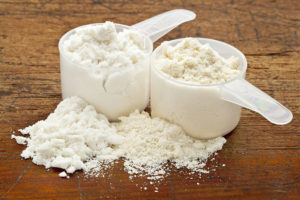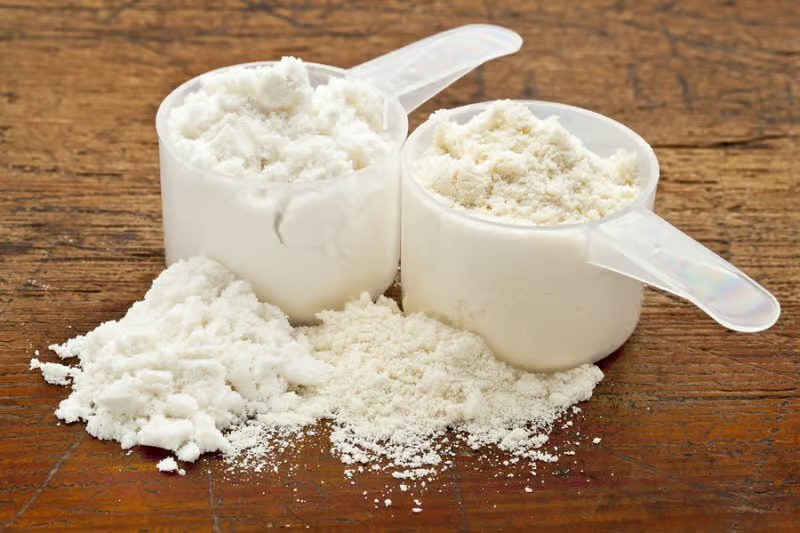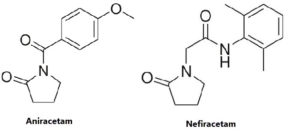Table of Contents
Nefiracetam is a fat-soluble nootropic in the racetam-class of compounds. Nefiracetam is considered more potent than the original racetam, Piracetam.
Nefiracetam was developed by Daiichi Seiyaku in the 1990’s as a treatment for cerebrovascular disorders. In 1999, Nefiracetam was in phase II clinical trials in the USA for treatment of cognition problems as a consequence of stroke, and Alzheimer’s type dementia.[i]
It is similar in structure to Piracetam with a phenyl group and two methyl groups added to the amine of Piracetam. Nefiracetam, like all racetam nootropics, has a pyrrolidone nucleus at its core. The structure of Nefiracetam is similar to Aniracetam.
Nefiracetam is used as a prescription drug in Japan. And as a supplement in the United States.
Relatively new to the nootropics community. Neurohackers use Nefiracetam to boost learning, cognition and memory.
Nefiracetam helps:
- Neuroprotection: Nefiracetam helps control NMDA signaling which protects against excessive glutamate levels. Glutamate is powerful excitatory neurotransmitter. Too much glutamate damages neurons and the entire brain.
- Neurotransmitters: Nefiracetam modulates GABA levels in the brain. Reducing GABA when it’s too high, and increasing GABA levels if they’re too low. Producing a calm-like focus and reducing anxiety. Nefiracetam prolongs the opening of calcium channels. Keeping neurotransmitters active longer. Improving memory formation and recall.
- Acetylcholine: Nefiracetam potentiates nicotinic acetylcholine receptors. Boosting the release of GABA and glutamate. Producing a calming effect while improving neuroplasticity and boosting learning and memory.
Overview
Nefiracetam (DM-9384, N-(2, 6-dimethylphenyl)-2-(2-oxopyrrolidine-1-yl)-acetamide) is in the racetam-family of nootropic compounds. It is a fat-soluble nootropic.

The racetam-class of nootropics have a pyrrolidone nucleus at their core. And Nefiracetam is a cholinergic compound, meaning it affects acetylcholine levels in the brain.
Nefiracetam is used as a prescription drug in Japan. It is sold as an over-the-counter, unrestricted compound in the United States. But not as a dietary supplement.
One of the most recent synthetic nootropic compounds, it is known as a cognitive enhancer. And is known for its anxiolytic, or anti-anxiety effects.
Nefiracetam is considered to be much more potent than Piracetam. As a nootropic, it helps increase attention span, alertness, cognition, learning and boosts memory.
Nefiracetam vs. Piracetam: What’s the Difference?
Japan-based pharmaceutical company Daiichi Seiyaku developed Nefiracetam in the late 1990’s as a derivative of Piracetam.

Nefiracetam is fat-soluble while Piracetam is water-soluble. Fat-soluble molecules cross the blood-brain barrier more easily than water-soluble molecules.
Both Nefiracetam and Piracetam are cognitive enhancers. And both have neuroprotective qualities. Both racetams are able to improve learning and memory. And both are able to prevent brain damage.
Nefiracetam has additional benefits not shared with Piracetam. Nefiracetam can reduce anxiety and depression. And exhibits several other memory enhancing qualities over Piracetam.
Nefiracetam increases the amount of time calcium channels in neurons remain open. Tied to protein kinase A (PKA) and the Gi alpha subunit (Gi/o protein), signaling is enhanced in the neuroreceptor independent of the synapse. This calcium channel pathway is critical for long-term potentiation (LTP) and the formation of long-term memories.[ii]
Nefiracetam also potentiates protein kinase C alpha (PKCα) which is involved in long-term potentiation (LTP).[iii] PKCα is dependent on glutamate signaling.
And Nefiracetam activates Ca2+/calmodulin-dependent protein kinase II (CaMKII) which is critical in memory formation. Again dependent on glutamate signaling.[iv]
Finally, Nefiracetam potentiates acetylcholine receptors in the hippocampus which encourages glutamate release and LTP. Piracetam does not share this memory enhancing quality.[v]
The bottom-line is Nefiracetam seems to be a much more potent memory enhancer that the original nootropic Piracetam.
How does Nefiracetam work in the Brain?
Nefiracetam boosts brain health and function in several ways. But two in particular stand out.
- Nefiracetam enhances memory. In several studies and clinical trials, researchers have noted Nefiracetam’s anti-amnesia effects. And they’ve arrived at this observation by noting Nefiracetam interacting with individual acetylcholine receptors in the brain.
One study conducted at the Albert Einstein Healthcare Network in Philadelphia worked with older rabbits. Researchers use a technique called the “nictitating membrane (NM)/eyeblink response” in rabbits which is used in the lab to study age-related memory disorders.
In this case, the team used Nefiracetam to study its effect on retention and relearning. The scientists administered 5, 10 or 15 mg/kg of Nefiracetam to 34 “retired” rabbits over 15 days. And then tested retention and relearning 1, 5 and 12-weeks post-training.
The researchers found that the effect of Nefiracetam on the ability of older rabbits to relearn was apparent up to 5 weeks after using Nefiracetam. In other words, Nefiracetam had a significant effect on memory long after the rabbits stopped using it.
The researchers concluded that Nefiracetam likely has an even greater effect on memory the longer you use it.[vi]
This testing model is dependent on cholinergic (acetylcholine) firing in the brain.[vii]
- Nefiracetam alleviates depression. Nefiracetam enhances signaling of GABA on GABAa receptors when GABA is too low. And has a suppressive effect when GABA is too high.[viii] Leading to stabilized mood and sociability. No mood swings!
Nefiracetam also provides an antidepressant effect by activating the enzyme Ca2+/calmodulin-dependent protein kinase II (CaMKII). Scientists in Japan worked with mice with depressive-like behaviors. The mice were given 1 mg/kg per day of Nefiracetam. And noticed antidepressant effects within a day of supplementation.[ix]
Note that this antidepressant effect takes a completely different approach to controlling depression compared to SSRI’s. These prescription antidepressants mess with serotonin levels in your brain to control depression. And come with a host of side effects.
Also note that the CaMKII enzyme is associated with a boost in long-term memory formation.
How things go bad
Glutamate is an excitatory relative of GABA. While GABA has a calming effect, glutamate stimulates. Glutamate is the most common neurotransmitter in the central nervous system.
But glutamate is actually toxic to neurons. And too much of it in your brain can kill brain cells. Lou Gehrig’s Disease for example, is caused by excess glutamate.
But glutamate is a pivotal neurotransmitter in the brain. It links the brain circuits involved in memory, learning and perception.
↑ Too much glutamate can kill neurons
↑ Too much GABA can cause brain damage
↓ Too little GABA can cause depression
↓ Too little glutamate can cause problems with memory, learning and perception
↓ Acetylcholine levels decline
All of these changes can happen at any age. And are a product of the food we eat, what we drink, lifestyle habits, the air we breathe and more.
So Nefiracetam can help for age-related cognitive decline, as well as a student looking to do better in school. By boosting acetylcholine and controlling glutamate and GABA in the brain.
Nefiracetam benefits
Nefiracetam modulates GABA (gamma aminobutyric acid) in your brain. GABA is the primary inhibitory neurotransmitter in the brain. Its role is to keep glutamate, the primary excitatory neurotransmitter from overwhelming your brain. And causing damage.
When GABA levels are too low, you experience anxiety, insomnia, poor mood and restlessness. Left unchecked it can lead to neurodegenerative disease and a very poor quality of life.
But when GABA is too high, you have a toxic environment in your brain. Causing damage to neurons and other areas of your brain. Nefiracetam modulates GABA levels, keeping them steady for a healthy brain. And improved long-term memory.
Nefiracetam contributes to learning by enhancing long-term potentiation (LTP). Enhancing NMDA-dependent LTP at low concentrations and AMPA dependent LTP at higher concentrations.[x]
Nefiracetam combined with choline boosts the production of the crucial neurotransmitter acetylcholine. Improving memory, recall and focus.
Nefiracetam is fat-soluble and quickly enters your brain after you take it. Once in your brain, it boosts signal transmission, and protects neurons.
Nefiracetam boosts acetylcholine so you should take it with a good choline source. Try Alpha GPC or CDP-Choline with Nefiracetam. And give your brain the choline it needs.
How does Nefiracetam feel?
Several studies have noted that short-term or one-time use of Nefiracetam doesn’t do much. But supplementing Nefiracetam every day for 7 days or more is needed to experience the full benefit of this nootropic.
Nootropics users report:
- Nefiracetam as a study aid. Nefiracetam provides calm focus, recall and cognition for many neurohackers. It improves attention span, motivation, and alleviates apathy and mental fatigue.
- Increased visual acuity. The visual effects of Nefiracetam feel like your brain is processing a broader spectrum of what’s in your visual range. Nature and your surroundings look more vibrant and beautiful.
- Mood. Many users report a calm focus and being able to articulate thoughts, and improved speaking ability. Language and your vocabulary seem to flow effortlessly. Thoughts and ideas come with less effort.
Some experienced users of Aniracetam say they prefer Nefiracetam. You may recall that the chemical structure of Nefiracetam is very similar to Aniracetam. And the clinical studies support its superior ability to affect memory.
You should be able to experience the full effects of Nefiracetam within 7 days of starting to supplement with it. It’s fat-soluble so it’s digested and enters your cells quickly.
Nefiracetam Research
Nefiracetam was developed by a company in Japan in the late 1990’s. As a result, the majority of the published research available in the Western directories was conducted in Japan. And most of it on rats and mice.
Clinical trials for Nefiracetam have been conducted in China and the USA for use in treating Alzheimer’s Disease. So far, no large pharmaceutical company in the USA has formulated a prescription drug version of Nefiracetam to my knowledge.
Nefiracetam as an Antidepressant
Researchers at the University of Iowa in the USA conducted a double-blind, placebo-controlled trial with 159 stroke patients with major depression. Patients received 600 mg or 900 mg of Nefiracetam or a placebo within 10 days to 3 months after their stroke.
The trial ran for 12 weeks with patients evaluated at 4, 9 and 12 weeks of the trial. The study concluded that Nefiracetam produced a significant improvement in the most severely depressed patients.[xi]
Nefiracetam Improves Learning & Memory
Much of the research on Nefiracetam has been done with learning and memory in mind.
One study conducted in Ireland used Nefiracetam with rats. Scopolamine, a memory inhibitor, was given to the rats while they were in training. Scopolamine is used to purposely inhibit memory. When the researchers gave the memory-deprived rats Nefiracetam, task recall improved and significantly improved memory deficits.[xii]
Another Irish study with rats showed 40-days of Nefiracetam supplementation induced Nerve Growth Factor and neurogenesis. Proving that Nefiracetam could facilitate long-term memory consolidation.[xiii]
Nefiracetam Reduces Apathy
Supplementing with Nefiracetam is reported by many neurohackers to boost motivation and a “get it done” attitude. Which is the opposite of ‘apathy’.
Stroke patients who suffer depression commonly experience apathy. Researchers at he University of Iowa conducted a study with 137 stroke patients with major depression. 70 of which also met published diagnostic criteria for apathy.
The patients were assigned a placebo, or 600 mg or 900 mg of Nefiracetam per day for 4 weeks. Patients who used 900 mg of Nefiracetam had a significantly greater improvement in Apathy Scale scores compared to the other two groups. Conclusion: Nefiracetam reduces apathy.
Nefiracetam Recommended Dosage
Recommended Nefiracetam dosage is 100 mg to 900 mg per day. Taken in divided doses. One Nefiracetam dose in the morning, and one in the early afternoon.
Nefiracetam is sold in tablet, capsule and powder form. Tablets and capsules are usually 400 – 600 mg each.
Since Nefiracetam is a fat-soluble nootropic, you should take it with a meal containing healthy fats. Or with a tablespoon of extra virgin, expeller cold-pressed coconut or olive oil. Or other similar healthy fat to ensure quick absorption.
Nefiracetam also boosts acetylcholine (ACh) activity in your brain. To avoid a “racetam headache” make sure to stack Nefiracetam with a good choline source like CDP-Choline or Alpha GPC.
Note that most studies suggest, and many neurohackers report that it will take at least 7 days of daily dosing of Nefiracetam to experience the full benefit of this nootropic.
Nefiracetam Side Effects
Nefiracetam non-toxic. So is considered well-tolerated and safe.
Side effects are rare but can include anxiety, fatigue, headaches, nervousness and nausea. Side effects are often a result of unusually high doses of the nootropic.
Headaches from using Nefiracetam typically happen when you forget to combine it with a good choline supplement. Headaches are often a symptom of a choline deficit in your brain.
Nearly all of the toxicity studies on Nefiracetam have been done on animals. And prolonged usage of this nootropic have shown no toxic effects at recommended doses.
One study with male Beagle dogs reported a reduction in testicular testosterone after a single treatment of Nefiracetam.
But before you write this nootropic off, note that the dose was a ridiculous 180 or 300 mg/kg dose.[xiv] That’s the equivalent of 16 or 27 grams of Nefiracetam for a 200 lb. male human.
And dogs happen to metabolize Nefiracetam differently than humans and primates. The metabolite M-18 in dogs seems to be the culprit. And is not found in humans or monkeys.[xv]
I’m not going to belabor this point. But to say that Nefiracetam is safe and non-toxic if used at recommended doses. Just don’t give it to your dog.
Where to Buy Nefiracetam
Nefiracetam is sold in tablet, capsule and powder form. Tablets and capsules are usually 400 – 600 mg each.
I recommend Click for Science.bio- Nefiracetam who sell Nefiracetam as a “research” compound. It is sold to be used in an academic laboratory research setting. They go on to state “nothing we sell is intended for nor is it manufactured for diagnostic or therapeutic purposes in humans.”
Nootropics Expert Recommendation
Nefiracetam 100 – 900 mg per day
 I recommend using Nefiracetam as a nootropic supplement.
I recommend using Nefiracetam as a nootropic supplement.
Your body does not make Nefiracetam on its own. So to get its benefits you must take it as a supplement.
Nefiracetam is especially helpful for those suffering from apathy, loss of motivation and memory loss. Studies show it helps stop and reverse the symptoms associated with apathy.
And this nootropic helps boost the activity of GABA, glutamate and acetylcholine in your brain. All involved in long-term potentiation and formation of long-term memory.
Nefiracetam is also particularly useful to students and executives who want to boost cognition, learning and especially long-term memory. Neurohackers who use Nefiracetam say it helps boost study scores, work flow, learning and memory.
You should use Nefiracetam with a good choline supplement like Alpha GPC or CDP-Choline. It helps boost neural acetylcholine, so demands the presence of more acetylcholine in your brain.
You can safely boost daily intake of Nefiracetam to 1,200 mg if needed. All daily dosing of Nefiracetam should be in divided doses if above 200 mg per day. One dose in the morning and another early afternoon.
I recommend Click for Science.bio- Nefiracetam










Join The Discussion - 41 comments
Benji
December 1, 2025
Hello, is it true that it is the only noos which has no tolerance ?
David Tomen
December 1, 2025
Benji, the only racetam that is widely known to be susceptible to tolerance is Phenylpiracetam. Keep in mind that each racetam we use as a nootropic in the USA is a prescription drug somewhere in the world. Doctors do not prescribe drugs knowing that their patient would grow “tolerant” to that drug.
But we humans are funny. If we get a sensational benefit from a nootropic then we want that feeling to happen every time we use it. But that is simply not sustainable. My advice is choose the racetam that works best for you. And look at the science on how it works and what to expect.
I’ve been using Aniracetam daily for years and never grown “tolerant” to is. Does it feel the same as the first time I used it? No, but it provides the benefits I am looking for including better verbal fluidity.
Morris
September 20, 2024
Hi David – The science bio powder form doesn’t have label dosage information. Is there a scoop included, if so, what’s the equivalent amount? Thanks.
David Tomen
September 20, 2024
Morris, the recommended Nefiracetam dosage is 100 mg to 900 mg per day. But I suggest starting at the lowest dosage of 100 mg at first to see how you react to this nootropic. And don’t forget to take it with 300 mg CD-Choline and 500 mg ALCAR.
The best way to measure your dose is by using a micro scale like this one: https://geni.us/6qB0s
Petra
April 20, 2024
David – Would you happen to know anything about concerns re Nefiracetam and resulting cyp3a4 metabolites? Noted this on reading various forums and suggestions being to take cyp3a4 inhibitors. Any feedback would be appreciated.
David Tomen
April 22, 2024
Petra, Cytochrome P450 3A4 is a cytochrome enzyme that metabolizes many different drugs in your liver. When you inhibit that enzyme you may not get the benefit of whatever drugs you are on. But I’ve never heard of this with Nefiracetam.
C-J Belle
March 23, 2024
Why does nootropic source and a few other sites that sell racetam powders say that their products are not for human consumption?
David Tomen
March 29, 2024
C-J, because none of the racetams have been approved by the FDA. And the FDA does not recognize the racetams as dietary supplements. Companies that have sold the racetams by making claims that they cure certain diseases have been shut down.
So, most supplement vendors are afraid to sell any racetam. Companies that sell them do not make any claims and also include things like “not for human consumption” or “for research purposes only”. They do this for legal reasons.
Lauren
February 28, 2024
I’m considering buying from Science.bio and was just wondering, is it necessary to make your own capsules in order to take the powder or can you just sprinkle a scoop into your mouth?
David Tomen
March 1, 2024
Lauren, it depends on the supplement. Some taste really nasty so you would not want to “sprinkle a scoop into your mouth”. Another option if you don’t want to make capsule is put the powder in a drink like a smoothie that you like and take it that way.
Min
November 30, 2023
Summary: Is ‘akersunder’ on amazon.com a trustworthy seller?
First of all, I would like to thank you.
Your articles have helped me a lot, and the best part is that your articles are updated frequently with the latest information.
I recently tried to buy Nefiracetam from Science.bio. I wanted to buy it with my credit card, but they only had cryptocurrency and eCheck as payment methods. I also tried signing up for Checkbook.io and Coinmama as their site says, but I couldn’t do anything since I don’t have a bank account in the US. In the end, I gave up on buying from Science.bio.
Then I found a seller named Akersunder Nefiracetam Powder on amazon.
Is this a trustworthy seller?
David Tomen
November 30, 2023
Min, I’ve never heard of that seller and they have zero reviews. I personally would not consider buying from them.
If you look at Science.bio’s FAQ page it says, “We support payment with credit card, eCheck, bank transfer (ACH, international wire), cryptocurrency (bitcoin, altcoins)”.
Science.bio was forced out of business for well over a year because of pressure from the FDA and credit card companies simply because they are selling products not “approved” as dietary supplements. It is a miracle that they found a credit card company willing to work with them because this is an ongoing problem in this industry. But if you simply cannot use a credit card they also accept bank transfers. And the bank does not need to be in the USA.
Kk
February 17, 2024
Have you tried ordering from akersunder? If so, what was the outcome?
M&M
February 17, 2025
Yes/effective as in good, but that depends on several factors. Because not everyone is the same or has the same issues. You’ve gotta do your research and get to know your own needs. Sometimes your needs can be filled by a food, nootropic, herb, or a vitamin and sometimes all the above. My advice would be to cut out all things that might be damaging your brain. Eat food that will benefit your brain and body. Cut out all bad foods and look for good foods to reward yourself not candy or alcohol.
Andrei
October 25, 2023
Hi there,
How would this supplement interact with calcium blockers?
Thank you!
David Tomen
October 27, 2023
Nefiracetam increases calcium channel currents (https://pubmed.ncbi.nlm.nih.gov/8032872/) so it may negate the benefit of your calcium channel blocker.
virginia
January 20, 2025
Hi david, if nefiracetam increases calcium channel currents, is that a good or bad thing? I take 20,000 IU of Vit D and some Vit K to negate calcium build up in the wrong areas. Would the nefiracetam interfere with that in a bad way? thanks
David Tomen
January 20, 2025
Virginia, Nefiracetam does NOT increase calcium. This sentence explains how it works. “Nefiracetam increases the amount of time calcium channels in neurons remain open. Tied to protein kinase A (PKA) and the Gi alpha subunit (Gi/o protein), signaling is enhanced in the neuroreceptor independent of the synapse. This calcium channel pathway is critical for long-term potentiation (LTP) and the formation of long-term memories.”